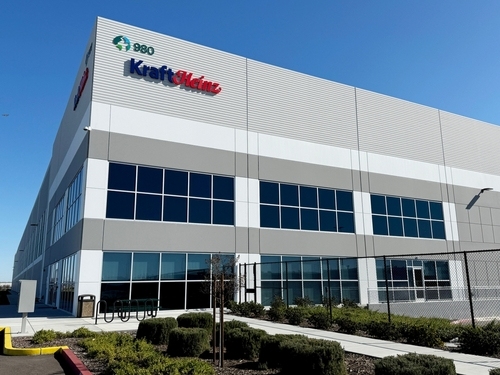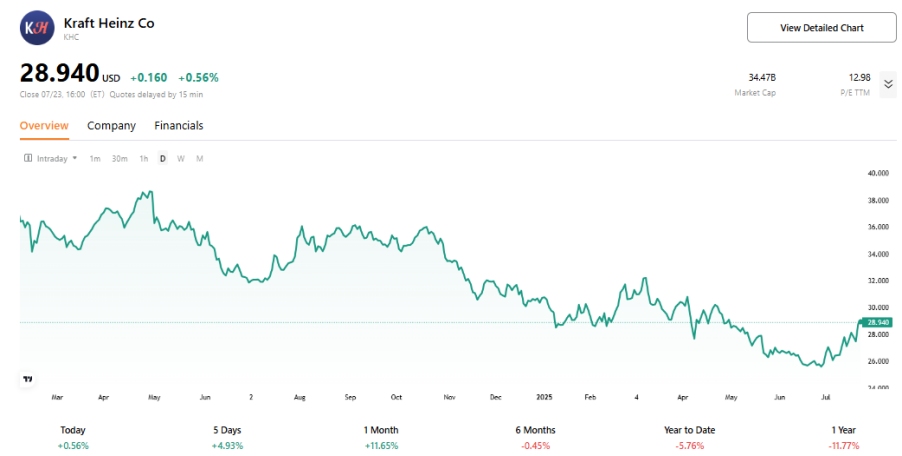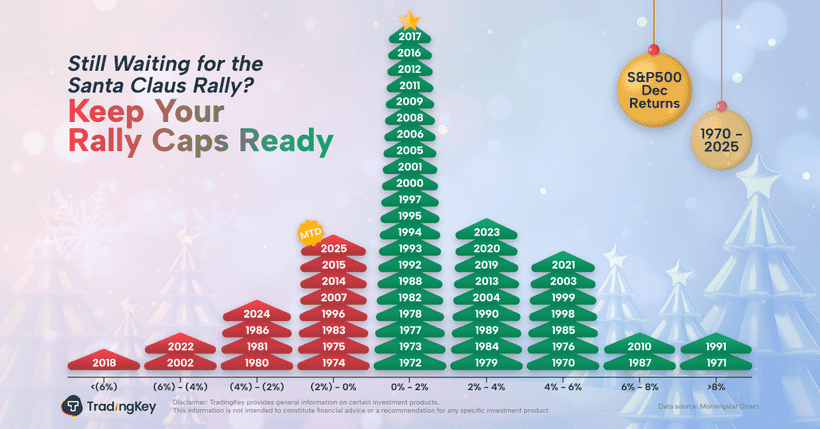Kraft Heinz: Buffett, Is It Time to Sell?

Investment Thesis
TradingKey - Kraft Heinz (KHC), the world’s fifth-largest food and beverage company, boasts a strong brand portfolio and diversified revenue streams, with North America accounting for nearly 75% of its income. However, its stock price has fallen over 60% in the past five years, and 2024 revenue showed negative growth, reflecting weak demand, intensified competition, and pressures from health-conscious eating trends. Despite this, the company’s growth potential in emerging markets, stable cash flow, and dividend policy provide support for its long-term value. Its current P/E ratio of 13 is below the industry average, but a PEG ratio of 8.08 suggests the valuation remains high.
Although the company still has growth potential in emerging markets in the long term, its short-term growth weakness and innovation bottleneck make it difficult to support a stock price rebound. Based on Buffett's value investing philosophy, Kraft Heinz's current risk-reward ratio is no longer attractive, and selling the stock to reallocate capital to opportunities with greater growth prospects may be a wiser choice.

Source: TradingKey
.jpg)
Source: Kraft Heinz, TradingKey
Company Overview
Kraft Heinz Company (KHC), formed in 2015 through the merger of Kraft Foods Group and H.J. Heinz Company, is headquartered in Chicago, USA. It is the third-largest food and beverage company in North America and the fifth-largest globally, with annual sales of approximately $26 billion in 2024. The company boasts over 200 brands, including well-known names like Kraft, Heinz, Oscar Mayer, and Philadelphia Cream Cheese. The merger was facilitated by Warren Buffett’s Berkshire Hathaway and 3G Capital, with Berkshire Hathaway currently holding about 27.5% of the shares, making Kraft Heinz its eighth-largest holding, accounting for nearly 4% of its total investment portfolio. However, since the 2015 merger, Kraft Heinz's stock price has fallen by over 60%, raising concerns among investors about its future performance. Given this stock performance, is it time for Buffett to sell his Kraft Heinz shares?
.jpg)
Source: TradingKey
Financial and Market Performance
Kraft Heinz’s product portfolio spans multiple categories, including condiments, cheese and dairy, meats, convenient meals, beverages, and snacks, serving consumers in over 40 countries worldwide. Through its own sales organization, as well as independent brokers, agents, and distributors, Kraft Heinz’s products are sold to chain supermarkets, wholesalers, convenience stores, pharmacies, mass retailers, foodservice distributors, institutions (such as hotels, restaurants, and hospitals), and e-commerce platforms.
However, the food and beverage industry is highly competitive, with Kraft Heinz facing significant pressure from both global and local brands. Key competitors include Kellogg's, General Mills, Mondelez, Unilever, Nestlé, PepsiCo, Conagra Brands, J.M. Smucker, Hormel Foods, and Campbell Soup Company. These companies have diverse product lines, directly competing with Kraft Heinz in categories such as condiments, cheese, meats, convenient meals, and beverages.
Despite Kraft Heinz’s prominent position as the third-largest food and beverage company in North America and the fifth-largest globally, the company has faced multiple challenges in recent years, including slowing demand growth, intensifying competition, and shifting consumer preferences toward healthier, sustainable, and localized products. From a financial perspective, Kraft Heinz has maintained a relatively stable gross margin in the 31%-35% range, but revenue growth has been weak, with negative revenue growth in 2024. Profitability remains under pressure, with a declining margin trend. These challenges underscore the urgency for the company to find breakthroughs in a rapidly evolving market environment.
.jpg)
Source: Kraft Heinz, TradingKey
Revenue Structure - Regional Market Performance
Kraft Heinz’s revenue structure is highly diversified, spanning multiple geographic regions and product categories. From a regional perspective, North America is its core market, with net sales in the first quarter of 2025 approaching $4.5 billion, accounting for nearly 75% of the company’s total revenue. International developed markets (such as Europe and Australia) and emerging markets (such as Asia and Latin America) also contribute significant revenue. However, over the past five quarters, the company has experienced a year-over-year decline in sales growth across all markets, reflecting challenges from slowing global demand and intensifying competition.
.jpg)
Source: Kraft Heinz, TradingKey
From a more detailed perspective, Kraft Heinz’s performance over the past five quarters highlights persistent growth pressures. In North America, the company’s primary revenue source, organic net sales have continued to decline, worsening from -1.20% in the first quarter of fiscal year 2024 to -6.50% in the first quarter of fiscal year 2025. This decline is primarily driven by ongoing reductions in volume and product mix, though the company has partially offset these negative impacts through pricing strategies. However, the room for further price increases has significantly narrowed. International developed markets have similarly underperformed, with weak volume growth and diminishing pricing power. In contrast, emerging markets are the only region to maintain positive growth, though the growth rate has slowed from 5.50% in the first quarter of fiscal year 2024 to 3.90% in the first quarter of fiscal year 2025, with volume/product mix growth turning negative despite resilient pricing power in the region. Overall, Kraft Heinz faces dual pressures of weak demand and intensified competition in North America and international developed markets, while emerging markets, though a growth highlight, are losing momentum.
.jpg)
Source: Kraft Heinz, TradingKey
Revenue Structure - Product Performance
In 2020, Kraft Heinz reorganized its brand portfolio into three strategic platforms—Accelerate, Protect, and Balance—to optimize resource allocation, balance growth and profitability, and address industry competition and market challenges. The Accelerate platform focuses on high growth, the Protect platform maintains high profit margins, and the Balance platform provides stable cash flow.
The Accelerate platform includes Taste Elevation (Heinz Ketchup, Kraft Mayo), Easy Ready Meals (Kraft Mac & Cheese), and Substantial Snacking (Oscar Mayer snacks). Taste Elevation is the largest revenue contributor, with Heinz Ketchup holding approximately 70% of the U.S. market share, but its growth momentum has weakened, recording negative growth in 2024 and a year-over-year decline of 4.78% in Q1 2025. Easy Ready Meals and Substantial Snacking are also struggling, with both declining revenue contributions and negative growth rates. Inflationary pressures have led the company to rely on price increases to maintain profitability, but this may suppress sales volume, while the consumer shift toward healthier, low-sugar, and low-salt products further challenges growth.
.jpg)
Source: Kraft Heinz, TradingKey
The Protect platform encompasses Desserts (Jell-O, Kool-Aid) and Hydration (Capri Sun), aiming to maintain high profit margins for businesses with moderate growth potential. In 2024, the Protect platform generated $3.281 billion in revenue, accounting for nearly 13% of total revenue, but saw a year-over-year decline of 3.36%. In Q1 2025, revenue further dropped to $725 million, down 6.45% year-over-year. This performance reflects market softness, with the dessert business impacted by consumer preferences for low-sugar alternatives and the hydration segment facing intense competition from functional beverages and emerging brands. The Protect platform’s growth potential remains limited, requiring innovation in sugar-free desserts or functional beverages to revive market appeal.
.jpg)
Source: Kraft Heinz, TradingKey
The Balance platform includes Cheese, Coffee, and Meats, serving as a stable cash flow source to support investments in other platforms. In 2024, the Balance platform generated $5.216 billion in revenue, representing nearly 18% of total revenue, but experienced a year-over-year decline of 3.08%. In Q1 2025, revenue was $1.192 billion, down 6.44% year-over-year. The cheese business remains relatively stable in traditional markets but faces pressure from private-label brands. The coffee business contends with challenges from specialty and capsule coffee, while the meats segment is impacted by the trend toward plant-based alternatives. Although the Balance platform plays a critical role in cash flow generation, its overall business share is relatively small, and innovation efforts are hindered, leading to segment contraction.
.jpg)
Source: Kraft Heinz, TradingKey
Growth Potential
Kraft Heinz faces multiple challenges to its short-term growth, driven by health-conscious eating trends, economic uncertainty, and intensifying market competition. Consumers increasingly prefer low-sugar, organic, and plant-based products, prompting competitors like Nestlé and Unilever to accelerate the launch of healthier food options, capturing market share. Economic uncertainties, such as inflation and tariff pressures (e.g., rising coffee import costs), further constrain consumer purchasing power. Additionally, the company’s past reliance on cost-cutting rather than innovation has weakened its competitiveness in a rapidly evolving market. In the short term, Kraft Heinz faces significant growth pressures.
In the long term, Kraft Heinz’s strong brand portfolio, growth potential in emerging markets, robust financial position, and dividend policy provide a case for Warren Buffett to maintain his stake. Furthermore, the company’s plan to divest its grocery business and focus on faster-growing condiments and sauces may introduce short-term uncertainty but could enhance shareholder value over time by optimizing resource allocation. The key to future growth lies in the company’s ability to effectively execute its innovation strategy and capitalize on opportunities in emerging markets.
Valuation
Kraft Heinz’s current valuation reflects market pessimism about its growth prospects. The projected revenue growth rate over the next five years is only 0.46% annually, with earnings per share (EPS) expected to grow at 1.62% annually. The current price-to-earnings (P/E) ratio is approximately 13, below the food industry average (around 15-20), indicating low market confidence in growth. However, the price/earnings-to-growth (PEG) ratio, at 8.08, is significantly above the typical benchmark of around 1, suggesting the stock may still be overvalued. Although Kraft Heinz is striving to address industry competition and rapidly changing consumer preferences through product diversification and health-focused initiatives, the sustainability of its innovation remains to be seen in the long term.
Risk
· Health-Conscious Trends: Consumer preferences for low-sugar, organic, and plant-based foods threaten Kraft Heinz’s traditional processed food market share.
· Intense Market Competition: Major players like Nestlé and Unilever, along with emerging brands, are capturing market share through innovation, challenging Kraft Heinz’s core categories.
· Economic Uncertainty: Inflation and tariffs (e.g., rising coffee import costs) compress profit margins and reduce consumer purchasing power.
· Innovation Bottleneck: The company’s historical reliance on cost-cutting rather than product innovation hinders its ability to adapt to rapidly changing consumer demands.
· Business Divestiture Uncertainty: The planned spin-off of the grocery business may cause short-term volatility, with the success of this strategy yet to be proven.








